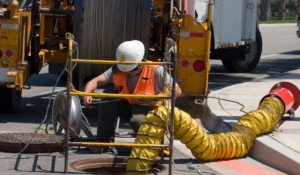On June 14 2022, two workers of an Arkansas construction company were found dead inside a newly installed sewer manhole. The two men were conducting testing below ground, in a confined space, before passing out from lack of oxygen.
When firefighters got to the scene, they sent air quality monitors into the manhole and found the atmosphere deficient of oxygen.
So, what went wrong?
Well, OSHA’s investigation indicated the Texarkana, Arkansas construction company in charge was responsible for eight critical safety violations: six serious and two willful. And, these safety violations played a major role in the workers’ deaths.
In particular, OSHA found that the company did not complete required planning before allowing workers to enter the space.
In pre-entry planning, a confined space must be tested for safety, including finding out if ventilation is needed.
The OSHA report also states the construction company did not train its workers for “confined space procedures,” failed to provide the necessary safety equipment, and neglected to obtain proper permits before the work.
The company now has 15 business days to comply or contest the findings.
Related Article: Carbon Monoxide Poisoning Claims Maintenance Worker’s Life
Confined Spaces and OSHA Standards
In 2020, the Bureau of Labor Statistics reported that 1,030 workers died in confined space incidents between 2011 to 2018. 61 of such deaths occurred in sewers, manholes, and storm drains.
Confined spaces are work spaces not designed for continuous human occupancy, and difficult to exit in the event of an emergency.
Examples include: manholes, crawl spaces, and holding tanks. People working in confined spaces face life-threatening hazards like toxic substances, electrocutions, explosions, and asphyxiation (due to low oxygen levels).
OSHA Standard 1910.146; stipulates the requirements for practices and procedures to protect employees in general industry from the hazards of entry into permit-required confined spaces.
OSHA states that the minimum “safe level” of oxygen in a confined space is 19.5%, while the maximum “safe level” of oxygen in a confined space is 23.5%. If a confined space’s oxygen concentration is beyond 23.5%, the space is too oxygen-rich and could result in the ignition of combustible gases present.
On the other hand, if the oxygen level is low, it could impair judgment and coordination. Extremely low oxygen levels in a confined space can cause nausea, vomiting, loss of consciousness, or, like in this case, even death.
Related Article: Are you using NIOSH approved N95 respirators?
Respiratory Protection for Workers in Confined Spaces
After you analyze the atmosphere of confined spaces, appropriate respirators should be provided for all entering workers.
First of all, it’s important to assess the worksite contaminant levels, like chemicals or toxins that may be involved. You’ll also need to stay up-to-date with the latest limitations for respiratory protection devices. This helps ensure you choose the right option for your needs, and helps prevent any accidents from occurring.
The recommended confined-space respirator types include:
- SCBA (self-contained breathing apparatus)
- Dual-purpose SCBA
- Combination air-line respirators with escape cylinder
- Air-purifying respirators
- Escape respirators.
NIOSH certification guarantees filtration efficiency, but not protection.
If a mask does not properly fit, it does not provide optimal protection. Respirators should form a tight seal to the face; otherwise, particles can leak into the breathing area. That’s why you need to conduct respirator fit tests at least once per year, or when conditions change.
Also, different jobs pose different dangers, whether it’s for confined spaces or anything else. That means it’s critical you choose the right respirator for the task at hand.
*** About Worksite Medical
In most cases, OSHA requires medical surveillance testing, and at no cost to employees. Worksite Medical makes that program easier with mobile medical testing.
We conduct on-site respirator fit tests, as well as audiometric exams, pulmonary function tests and heavy metal lab work, right on your job site. We also keep accurate, easy-to-access medical records for your convenience.
You’ll keep your employees at work, and stay ahead of OSHA inspections.




